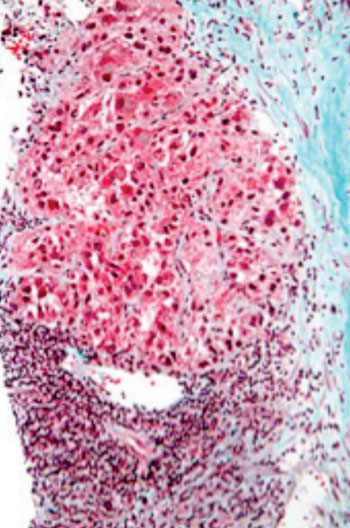Analysis of Isotope Imbalance May Aid Liver Cancer Diagnosis
By LabMedica International staff writers
Posted on 02 Mar 2015
A novel approach for diagnosing liver cancer (hepatocellular carcinoma) is based on analytical methods frequently used in the earth sciences.Posted on 02 Mar 2015
Hepatocellular carcinoma (HCC) is the most common type of liver cancer. Most cases of HCC are secondary to either a viral hepatitis infection (hepatitis B or C) or cirrhosis (alcoholism being the most common cause). Compared to other cancers, HCC is a rare tumor in the United States. In countries where hepatitis is not endemic, most malignant cancers in the liver are not primary HCC but metastasis of cancer from elsewhere in the body.

Image: Micrograph of hepatocellular carcinoma taken from a liver biopsy and colored with trichrome stain (Photo courtesy of Wikimedia Commons).
Investigators at the École Normale Supérieure de Lyon (France) analyzed the ratios of stable copper (Cu) and sulfur (S) isotopes in liver cancer patients. This study was a hi-tech look into observations dating from as far back as 1928 indicating that the hypoxic tumor environment altered the normal metabolism of elements such as copper and sulfur as well as the redox state of the metals, impacting their ability to bind to ligands.
Specifically, the investigators used the stable isotope compositions of copper (65Cu/63Cu) and sulfur (34S/32S) in the blood of patients with (HCC) as a tool to explore cancer-driven copper and sulfur imbalances.
They reported that copper was 63Cu-enriched by about 0.4% and sulfur was 32S-enriched by about 1.5% in the blood of patients compared with that of control subjects. HCC patients had more copper in red blood cells and serum compared with control subjects. However, the isotopic signature of this blood extra copper burden was not in favor of a dietary origin but rather suggested a reallocation in the body of copper bound to cysteine-rich proteins such as metallothioneins. The magnitude of the sulfur isotope effect was similar in red blood cells and serum of HCC patients, implying that sulfur fractionation was systemic. The 32S-enrichment of sulfur in the blood of HCC patients was compatible with the notion that sulfur partly originated from tumor-derived sulfides.
First author Dr. Vincent Balter, professor of geology at the École Normale Supérieure de Lyon, said, "This indicates that the blood 65Cu levels would decrease as a function of the severity of the cancer, which would be of interest for the estimation of tumor burden. The enrichment of blood with the 32S isotope may provide new biomarkers for cancer detection and monitoring."
The study was published in the January 27, 2015, issue of the journal Proceedings of the National Academy of Sciences of the United States of America (PNAS).
Related Links:
École Normale Supérieure de Lyon













